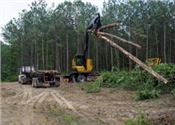High Construction Costs Not Reflected In Timber Prices
STARKVILLE, MISS.
Although construction costs are through the roof timber prices have not kept pace, and Mississippi forest landowners are waiting for improved markets.
Shaun Tanger, a forestry economics specialist with the Mississippi State University Extension Service, said the recent increase in construction costs is a demand-side phenomena.
“The thing driving the costs of construction materials is an economy flush in newly printed money and low interest rates,” Tanger said.
Tanger said he learned from his grandfather, who owned an apartment rental business for about 50 years, that “when money is cheap, people build.”
“Combine this current access to cheap money with the ability of many new workers to work remotely – meaning they can live in a different location from the office – and you have rapid increases in construction in medium-sized cities when comparing to larger cities like New York and Los Angeles,” Tanger said.
Compounding the issue was the fact that many mills were unprepared when COVID-19 struck, and some cut back or closed for a time, often months, due to government mandates.
“Lumber production was constrained right at the same time that interest rates cratered,” he said. “Since people were working from home, it allowed many to live elsewhere. You had a perfect storm of people looking for new homes, others engaging in remodeling at their existing homes, and a decrease in production capacity for the products that those groups were using.”
John Auel, MSU Extension Service forester and coordinator of the Professional Logging Manager Program, said severance tax records show about 1 million more tons of wood were harvested in 2020 than in 2019.
“In that sense, conditions are very good for timber,” Auel said.
“Growth far exceeds harvest across all products, which means we have ample supply. But that is also part of the issue with prices.”
As always happens with supply and demand, large supplies put downward pressure on prices, keeping timber values down. Auel said he does not expect to see timber prices rise much in the near future.
“The silver lining, in my opinion, is the interest in expanding existing mills and building new ones in the state, as has been announced recently,” Auel said. “We have the ability to sustainably harvest more timber to meet the increased demand. Increased competition will have a positive impact on stumpage values as well.”
But this economic perspective does not explain what is happening now, Tanger said.
“Mills are back at capacity and generating as much lumber as they ever have in the Southeast, but they just can’t meet the demand, so prices skyrocket,” Tanger said. “Rising prices are the signal that things are scarce relative to demand, and they sort those scarcer goods to those willing to pay higher prices.”
With timber prices low in recent years, there is a lot of standing timber in the state.
“We are still growing wood faster than we are harvesting it, even with the increased production of lumber, and other wood products add to that the glut left over from the recession, and it’s a wood mills’ – buyers’ – market,” Tanger said.
Marc Measells, MSU Extension forestry economist, said timber prices have not been good in recent years, and in the last few weeks have fallen about 45% from their peak.
“Current statewide stumpage prices for mixed hardwood sawtimber have continued to decline since a peak in 2016 and hardwood pulpwood prices have declined since 2019,” Measells said. “Pine sawtimber, chip-n- saw and pulpwood stumpage prices all increased to end 2020 and through the first quarter of 2021.”
Prices for the second quarter of 2021 will be published in early July. ∆

Timber prices have not kept pace with high construction costs because of high levels of supply. Jonathan White was operating a loader for Brian Smith Logging at a job site in Franklin County, Mississippi, on June 23, 2021.
Photo by MSU Extension Service/Kevin Hudson